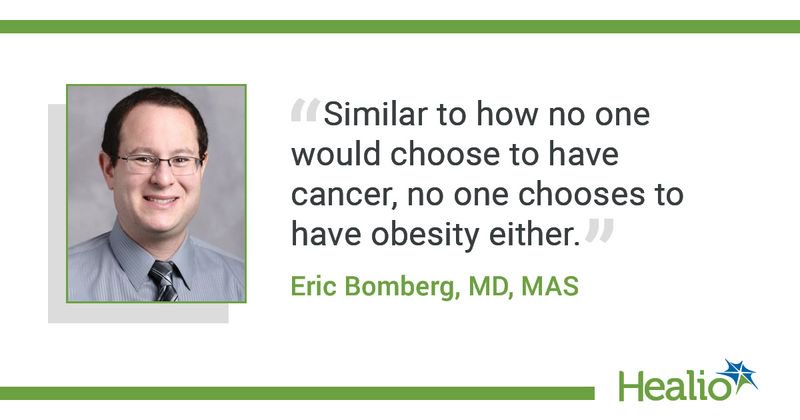Q&A: Is pediatric obesity a public health emergency?
Key takeaways:
- Public health strategies against obesity have not demonstrated significant success.
- Providers should know about and make resources available to patients and parents.
Last year, researchers reported that the prevalence of pediatric obesity increased to 21% in the United States between 2011 and 2020.
In a recently published perspective in Pediatrics, Eric M. Bomberg, MD, MAS, associate director for research informatics at the University of Minnesota’s Center for Pediatric Obesity Medicine, and colleagues wrote in favor of considering pediatric obesity a public health emergency.

We spoke with Bomberg about the changing pediatric obesity landscape, what public health strategies are lacking, and what providers can do to help combat obesity.
Healio: How has the landscape of pediatric obesity changed since the onset of the COVID-19 pandemic?
Bomberg: Studies have shown that obesity has worsened since the onset of the COVID-19 pandemic (ie, Lange and colleagues in MMWR), which is something we have seen in weight management clinics as well. Another significant change to come about from the pandemic is the availability of and substantial rise in virtual visits, which has overall made accessing care easier for many patients and families.
Healio: The perspective mentions that public health strategies have been implemented to reduce or prevent obesity without much “demonstrable success.” What are these efforts lacking?
Bomberg: To date, most previous public health strategies — for example, soda taxes — have overall not demonstrated significant success in terms of mitigating obesity. This is evidenced by the fact that, despite each of these efforts, obesity prevalence has only continued to rise over the years.
There are many potential reasons as to why these efforts have largely not been successful. However, I believe one of the main reasons is that they often ignore the nature of obesity. Obesity is a biologically and genetically driven disease that may be triggered by many forces that people have little to no control over — for example, our food and physical environments, socioeconomic status, strong commercial messaging, endocrine disruptors, epigenetics, stresses, etc. Many of the previous public health efforts to reduce or prevent obesity largely focus on changing behaviors; however, focus just on this without addressing these other forces is less likely to lead to any significantly meaningful impacts on reducing or preventing this disease.
Healio: What are some notable misconceptions about pediatric obesity?
Bomberg: I believe that the primary notable misconception about pediatric obesity is that it is a condition of choice, or that people choose to have obesity based upon the decisions that they make. Similar to how no one would choose to have cancer, no one chooses to have obesity either.
The very definition of a disease is a “deviations from the normal or healthy structure or function of a part, organ, or system of the body, caused by underlying etiologies, manifested by characteristic symptoms and signs, and resulting in pathological consequences that affect health, feeling, or function" (Jastreboff AM, and colleagues in Obesity).
Obesity indeed fits all of these criteria, namely, per the Obesity Society: “Obesity is a multicausal chronic disease recognized across the life-span resulting from long term positive energy balance with development of excess adiposity that over time leads to structural abnormalities, physiological derangements, and functional impairments. The disease of obesity increases the risk of developing other chronic diseases and is associated with premature mortality. As with other chronic diseases, obesity is distinguished by multiple phenotypes, clinical presentations, and treatment responses.”
Healio: What can providers do to combat pediatric obesity in their clinics?
Bomberg: The first step is increasing advocacy. Namely, providers should feel comfortable discussing the fact that obesity is a disease rather than a lifestyle choice. Doing so represents one important step toward creating a safe space to begin discussing the management of this disease, similar to how a provider would discuss the management of any other disease with their patient.
Providers should also know and make their patients and families aware that there are resources available to help. With the development of several new medications over the years with pediatric indications, there are now more tools available than there have ever been to help individuals living with this disease.
Although pediatric obesity continues to remain a dominant health issue in the U.S. and worldwide, it will take significant time and resources for us as a field to provide our patients with the best possible care for this disease. I believe that increasing advocacy to empower youth and families living with obesity is the most important first step to effectively addressing this pandemic.
References:
Bomberg EM, et al. Pediatrics. 2023;doi: 10.1542/peds.2023-061501.
Jastreboff, AM, et al. Obesity. 2019; doi: 10.1002/oby.22378.
Lange SJ, et al. MMWR Morb Mortal Wkly Rep. 2021;doi:10.15585/mmwr.mm7037a3.
